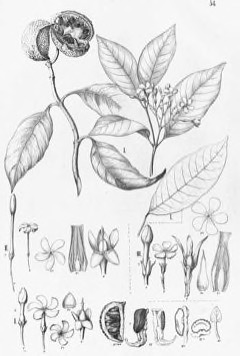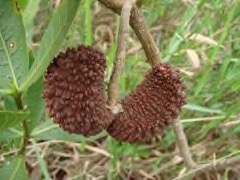 |
|
http://www.edibleplants.org |
 |
| João Medeiros flickr.com |
Translate this page:
Summary
A fast growing natural pioneer species found in Brazil, Tabernaemontana hystrix is a shrub or tree with a low but dense crown. It grows up to 6 m in height with a short and crooked bole that can be up to 30 cm in diameter. The plant is not edible and has no medicinal value. The wood is light in weight, soft, and not resistant to rot. Such characteristics make it an ideal use for boards, rafters and beams. It is also used for fuel and charcoal.
Physical Characteristics

 Tabernaemontana hystrix is an evergreen Tree growing to 5 m (16ft) by 5 m (16ft) at a fast rate.
Tabernaemontana hystrix is an evergreen Tree growing to 5 m (16ft) by 5 m (16ft) at a fast rate.
See above for USDA hardiness. It is hardy to UK zone 10.
Suitable for: light (sandy), medium (loamy) and heavy (clay) soils and prefers well-drained soil. Suitable pH: mildly acid, neutral and basic (mildly alkaline) soils. It cannot grow in the shade. It prefers moist soil.
UK Hardiness Map
US Hardiness Map
Synonyms
Peschiera fuchsiifolia (A.DC.) Miers Peschiera gaudichaudii (A.DC.) Miers Peschiera gracillima Miers
Plant Habitats
Edible Uses
References More on Edible Uses
Medicinal Uses
Plants For A Future can not take any responsibility for any adverse effects from the use of plants. Always seek advice from a professional before using a plant medicinally.
None known
References More on Medicinal Uses
The Bookshop: Edible Plant Books
Our Latest books on Perennial Plants For Food Forests and Permaculture Gardens in paperback or digital formats.

Edible Tropical Plants
Food Forest Plants for Hotter Conditions: 250+ Plants For Tropical Food Forests & Permaculture Gardens.
More

Edible Temperate Plants
Plants for Your Food Forest: 500 Plants for Temperate Food Forests & Permaculture Gardens.
More

More Books
PFAF have eight books available in paperback and digital formats. Browse the shop for more information.
Shop Now
Other Uses
Charcoal Pioneer Wood
Agroforestry Uses: A fast-growing natural pioneer that can quickly invade pasture, it also provides every year a large crop of fruits that are avidly eaten by birds. It is an essential choice for planting schemes to re-establish native woodland[419 ]. Other Uses The wood is light in weight, soft and with low resistance to rot. It can be used for boards in general, rafters and beams[419 ]. The wood is used for fuel and to make charcoal[419 ].
Special Uses
Attracts Wildlife
References More on Other Uses
Cultivation details
Grows best in a sunny position[419 ]. The plant can become a serious weed in pastures where it often self-sows freely and also sends up suckers from the roots[419 ].
References Carbon Farming Information and Carbon Sequestration Information
Temperature Converter
Type a value in the Celsius field to convert the value to Fahrenheit:
Fahrenheit:
The PFAF Bookshop
Plants For A Future have a number of books available in paperback and digital form. Book titles include Edible Plants, Edible Perennials, Edible Trees,Edible Shrubs, Woodland Gardening, and Temperate Food Forest Plants. Our new book is Food Forest Plants For Hotter Conditions (Tropical and Sub-Tropical).
Shop Now
Plant Propagation
Seed - best sown as soon as it is ripe in a partially shaded position or in the sun in a nursery seedbed or in individual containers. A germination rate in excess of 80% can be expected, with the seed sprouting within 30 - 40 days[419 ]. The seed remains viable in storage for at least 10 months[419 ].
Other Names
If available other names are mentioned here
Native Range
Coming Soon
Weed Potential
Right plant wrong place. We are currently updating this section.
Please note that a plant may be invasive in one area but may not in your area so it's worth checking.
The plant can become a serious weed in pastures where it often self-sows freely and also sends up suckers from the roots[419 ].
Conservation Status
IUCN Red List of Threatened Plants Status : This taxon has not yet been assessed

Growth: S = slow M = medium F = fast. Soil: L = light (sandy) M = medium H = heavy (clay). pH: A = acid N = neutral B = basic (alkaline). Shade: F = full shade S = semi-shade N = no shade. Moisture: D = dry M = Moist We = wet Wa = water.
Now available:
Food Forest Plants for Mediterranean Conditions
350+ Perennial Plants For Mediterranean and Drier Food Forests and Permaculture Gardens.
[Paperback and eBook]
This is the third in Plants For A Future's series of plant guides for food forests tailored to
specific climate zones. Following volumes on temperate and tropical ecosystems, this book focuses
on species suited to Mediterranean conditions—regions with hot, dry summers and cool, wet winters,
often facing the added challenge of climate change.
Read More
Expert comment
Author
Steud.
Botanical References
Links / References
For a list of references used on this page please go here
A special thanks to Ken Fern for some of the information used on this page.
Readers comment
| Add a comment |
|
If you have important information about this plant that may help other users please add a comment or link below. Only comments or links that are felt to be directly relevant to a plant will be included. If you think a comment/link or information contained on this page is inaccurate or misleading we would welcome your feedback at [email protected]. If you have questions about a plant please use the Forum on this website as we do not have the resources to answer questions ourselves.
* Please note: the comments by website users are not necessarily those held by PFAF and may give misleading or inaccurate information.
To leave a comment please Register or login here All comments need to be approved so will not appear immediately.
|
Subject : Tabernaemontana hystrix
|
|
|
|